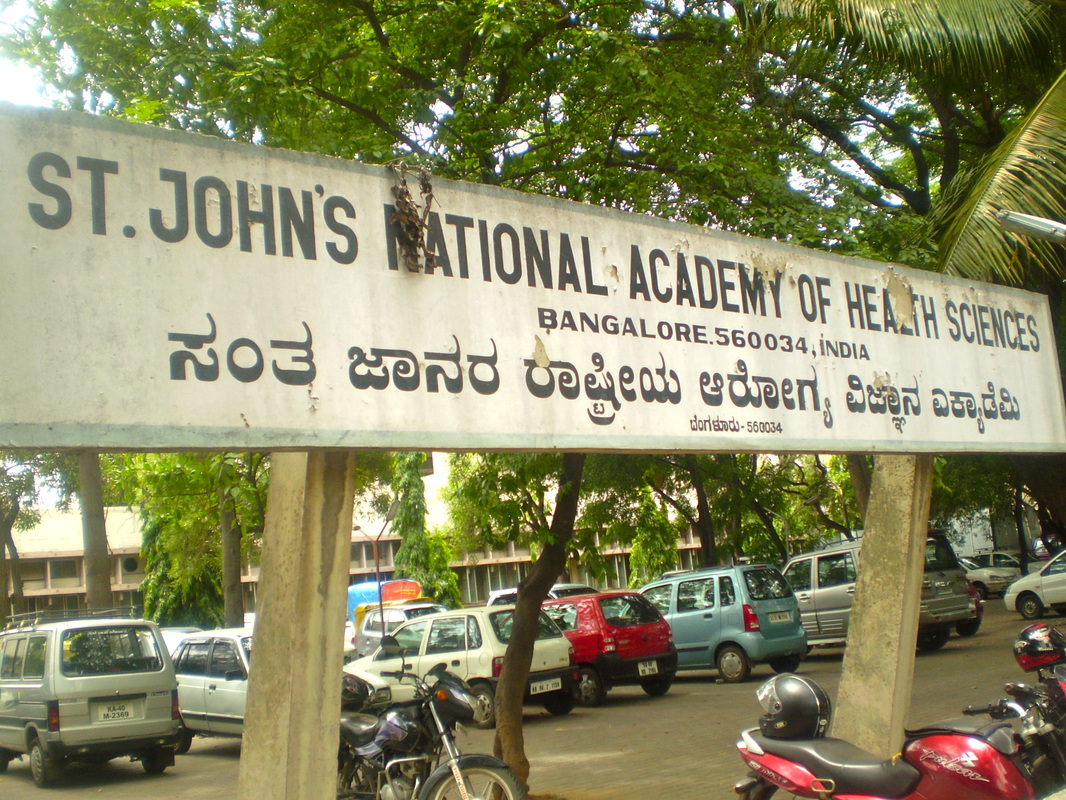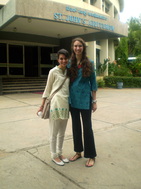Week 7: The Tinku Effectby Shaira Bhanji
It’s about 9AM at St. John’s Research Institute (SJRI) when a smiling lady in a colorful, neatly pleated sari walks in to her office. Dr. Tinku Thomas, M.Sc, Ph.D., (nicknamed “Tinks”) is a biostatistician and assistant professor at SJRI. It was around the second week of my internship at St. John’s Research Institute that I really began to get to know Tinku. I and two other interns effectively moved into her office for the summer…and we were grateful that we did. Our summer task involved learning how to use statistical software called SPSS (the program Stata is its counterpart). The purpose of SPSS was to help me make sense of a huge database of 2,000 pregnant women that included various body measurements, those of their babies, and data from food frequency questionnaires including every food group I could imagine. Needless to say, I at times felt like I was in over my head, drowning in waves of variables that overflowed like the Ganges.
7 Comments
Week 6: The Power of Milkby Shaira Bhanji
It’s no surprise that a mother’s nutrition is important to the health of her baby. It may, however, be surprising that the complications of a poor birth outcome do not stop at birth, but may come back to haunt the child’s adult life. Indeed, the well-known Barker’s hypothesis (also know as the Fetal Origins or Thrifty Phenotype hypothesis) states exactly this—that poor growth of the fetus during pregnancy leaves babies at higher risk of chronic disease later in life. Such diseases include type 2 diabetes, for example. I imagine being pregnant is hard enough even without having to worry about eating the right combination of nutrients to protect one’s baby more than fifty years after birth. And in some places, getting the right nutrients is harder than in others. Week 5: Farewell, Dear Indiaby Shaira Bhanji
As I sit here writing on my last full weekend in Bangalore, I distractedly flip through photo albums and try to soak in the fact that my time in India is coming to an end. I’ve just returned from Sukh Sagar, where we are now well-known by all the waiters as regulars. My travel buddy and I met up with our friend from Harvard—an experienced Bangalorian who first showed us around the city at the beginning of the summer. We sat drinking masala chai and lemon soda slowly as we recounted all the stories we had accumulated in our two months here. I vividly recall our first week, when our friend was showing us around the city: I was homesick, disoriented, and happy to see a familiar face. And now here I sat, after having thoroughly traveled and experienced India, talking about all the places I had been. Who knew that so much could happen in eight weeks? Week 4: Experiences are the Best Souvenirsby Shaira Bhanji
“[India is] like a wave; resist and you go under, ride it out and you arrive at the other side.”--The Best Exotic Marigold Hotel. 6:30 AM, Saturday, June 23rd: After a three-hour car ride, we awake to find ourselves at the entrance of Mysore Palace. With its fairytale-like architecture and fake-looking green gardens, it could be Disneyland. We lose ourselves in bold colors, high ceilings, and intricate architecture that saturate the former residence of the Mysore Kingdom’s Wodeyar family. I daydreamed about getting married in the Wedding Hall; the beauty of its stained glass dome ceiling surrounded by gold and turquoise pillars is enough to make even the plainest bride look stunning. After a casual play date with the ground’s elephants and camels, we arrive at Chamundi Hills to find monkeys enjoying orange soda. A lavish temple and bird’s-eye view of majestic Mysore await at the top of the rocky hill. * * * 8:00 PM, Friday, June 29th: I drift in and out of sleep between road bumps, the itch of bug bites, or blaring Bollywood music at rest stops en route to India’s east coast. We’re in the rural outskirts of Pondicherry, Tamil Nadu when I wake up for the last time eight hours later—sticky from the bus’ lack of AC. We watch the sun by the boardwalk overlooking the Bay of Bengal; enjoy pancakes India-style at a fan-cooled, tropical rooftop restaurant; and stroll along the French-named streets lined with fruit stands and Parisian-style buildings. The city is surprisingly calm as it awaits the arrival of Prime Minister Manmohan Singh. Week 3: Interview with Dr. Rebecca RajAssociate Professor, St. John's Research Institute at St. John's National Academy of Health Sciences in Bangalore, India
by Shaira Bhanji 1. Describe your role at St. John’s National Academy of Health Sciences. I have three faculty positions: one in the medical college, one in the research institute, and the other in the hospital. At the medical college, I am an Associate Professor in the Nutrition Division, where I teach classes. At the research institute, I focus on nutrition research, and in the hospital, I head the Clinical Nutrition Unit. In addition, I oversee the cafeteria at the institute. 2. What does your current research involve? What do you love most about your research? Mainly, my research in pediatric obesity—finding out the determinants and risk factors of it. Being a nutritionist, I understand that childhood is the most important phase for growing. I also do a lot of body composition and energy expenditure studies of both adults and children. 3. Have you lived in India your whole life? Yes. All my schooling was in Chennai, Tamil Nadu and then in Bangalore, Karnataka. Week 2: A Day in the Life...By Shaira Bhanji
The “Typical” Day: Senza Da Capo The melody of the day begins from the alarm of a small phone sleeping on a pillow dressed in sheets stamped with the seal of St. John’s Hospital. It’s 7:20AM, and my eyes roll open as the sound of rickshaw horns and the bark of dogs permeate the netted window to join in on the symphony. I throw off the bed sheets to feel the onset of itching and witness the redness that paints itself on my leg from the fresh kiss of a mosquito.…Welcome to India! I pick my shalwar for the day and slather on sunscreen, and then I hear another tune…the cheerful noise of a Skype call coming in from my family. Good morning or good evening—either greeting is appropriate given the 12.5-hour time difference between Bangalore and California. After sharing the latest occurrences and some virtual hugs, it’s time to fuel up for the day. If my suitemates and I aren’t eating oatmeal at home, you’ll find us at Sukh Sagar awaiting the arrival of two angelic rice cakes (called “idly”), which come to rest in front of me along with a hot cup of the finest masala chai I have ever tasted.
|
The Lab JournalWelcome to the summer internship series of 2012! Follow 9 Scientista bloggers through their summer internships to catch a glimpse of what it is like to be a scientista^TM. By Title- India Presents: A "New World Symphony"
- Through The Lens: The Intricacies Of Diabetes - Do Nanoparticles Glow? - Using Unusual Animals to Study Human Disease - Using the Hubble Telescope - You Think What You Eat - Experimenting With the Life of a Scientist(a) - 18.085: My Summer at MIT - Science Heals: A Summer of Global Health Research By BloggerRabeea Ahmed
Riana Balahadia Shaira Bhanji Nzuekoh Nchinda Amy Beth Prager Natalie Punt Juliet Snyder Pin-Wen Wang Stephanie Wang Archives |
The Scientista Foundation, Inc. All Rights Reserved © 2011-2021 | Based in NY | [email protected]
The Network for Pre-Professional Women in Science and Engineering
The Scientista Foundation is a registered 501(c)(3) -- Donate!
The Network for Pre-Professional Women in Science and Engineering
The Scientista Foundation is a registered 501(c)(3) -- Donate!




 RSS Feed
RSS Feed